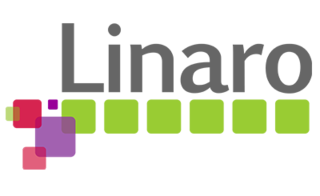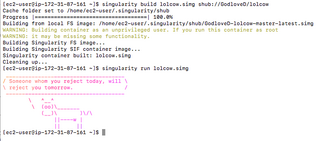Related Research Articles

Red Hat, Inc. is an American software company that provides open source software products to enterprises and is a subsidiary of IBM. Founded in 1993, Red Hat has its corporate headquarters in Raleigh, North Carolina, with other offices worldwide.

A supercomputer is a computer with a high level of performance as compared to a general-purpose computer. The performance of a supercomputer is commonly measured in floating-point operations per second (FLOPS) instead of million instructions per second (MIPS). Since 2017, supercomputers have existed which can perform over 1017 FLOPS (a hundred quadrillion FLOPS, 100 petaFLOPS or 100 PFLOPS). For comparison, a desktop computer has performance in the range of hundreds of gigaFLOPS (1011) to tens of teraFLOPS (1013). Since November 2017, all of the world's fastest 500 supercomputers run on Linux-based operating systems. Additional research is being conducted in the United States, the European Union, Taiwan, Japan, and China to build faster, more powerful and technologically superior exascale supercomputers.
Grid computing is the use of widely distributed computer resources to reach a common goal. A computing grid can be thought of as a distributed system with non-interactive workloads that involve many files. Grid computing is distinguished from conventional high-performance computing systems such as cluster computing in that grid computers have each node set to perform a different task/application. Grid computers also tend to be more heterogeneous and geographically dispersed than cluster computers. Although a single grid can be dedicated to a particular application, commonly a grid is used for a variety of purposes. Grids are often constructed with general-purpose grid middleware software libraries. Grid sizes can be quite large.

Db2 is a family of data management products, including database servers, developed by IBM. It initially supported the relational model, but was extended to support object–relational features and non-relational structures like JSON and XML. The brand name was originally styled as DB/2, then DB2 until 2017 and finally changed to its present form.
Yellow Dog Linux (YDL) is a discontinued free and open-source operating system for high-performance computing on multi-core processor computer architectures, focusing on GPU systems and computers using the POWER7 processor. The original developer was Terra Soft Solutions, which was acquired by Fixstars in October 2008. Yellow Dog Linux was first released in the spring of 1999 for Apple Macintosh PowerPC-based computers. The most recent version, Yellow Dog Linux 7, was released on August 6, 2012. Yellow Dog Linux lent its name to the popular YUM Linux software updater, derived from YDL's YUP and thus called Yellowdog Updater, Modified.
Cell is a 64-bit multi-core microprocessor microarchitecture that combines a general-purpose PowerPC core of modest performance with streamlined coprocessing elements which greatly accelerate multimedia and vector processing applications, as well as many other forms of dedicated computation.
Oracle Grid Engine, previously known as Sun Grid Engine (SGE), CODINE or GRD, was a grid computing computer cluster software system, acquired as part of a purchase of Gridware, then improved and supported by Sun Microsystems and later Oracle. There have been open source versions and multiple commercial versions of this technology, initially from Sun, later from Oracle and then from Univa Corporation.

David A. Bader is a Distinguished Professor and Director of the Institute for Data Science at the New Jersey Institute of Technology. Previously, he served as the Chair of the Georgia Institute of Technology School of Computational Science & Engineering, where he was also a founding professor, and the executive director of High-Performance Computing at the Georgia Tech College of Computing. In 2007, he was named the first director of the Sony Toshiba IBM Center of Competence for the Cell Processor at Georgia Tech.
IBM Spectrum LSF is a workload management platform, job scheduler, for distributed high performance computing (HPC) by IBM.

Platform Computing was a privately held software company primarily known for its job scheduling product, Load Sharing Facility (LSF). It was founded in 1992 in Toronto, Ontario, Canada and headquartered in Markham, Ontario with 11 branch offices across the United States, Europe and Asia.
GPFS is high-performance clustered file system software developed by IBM. It can be deployed in shared-disk or shared-nothing distributed parallel modes, or a combination of these. It is used by many of the world's largest commercial companies, as well as some of the supercomputers on the Top 500 List. For example, it is the filesystem of the Summit at Oak Ridge National Laboratory which was the #1 fastest supercomputer in the world in the November 2019 TOP500 list of supercomputers. Summit is a 200 Petaflops system composed of more than 9,000 POWER9 processors and 27,000 NVIDIA Volta GPUs. The storage filesystem called Alpine has 250 PB of storage using Spectrum Scale on IBM ESS storage hardware, capable of approximately 2.5TB/s of sequential I/O and 2.2TB/s of random I/O.

EPCC, formerly the Edinburgh Parallel Computing Centre, is a supercomputing centre based at the University of Edinburgh. Since its foundation in 1990, its stated mission has been to accelerate the effective exploitation of novel computing throughout industry, academia and commerce.

Univa was a software company that developed workload management and cloud management products for compute-intensive applications in the data center and across public, private, and hybrid clouds, before being acquired by Altair Engineering in September 2020.

Cloud computing is the on-demand availability of computer system resources, especially data storage and computing power, without direct active management by the user. Large clouds often have functions distributed over multiple locations, each of which is a data center. Cloud computing relies on sharing of resources to achieve coherence and typically uses a pay-as-you-go model, which can help in reducing capital expenses but may also lead to unexpected operating expenses for users.
Windows HPC Server 2008, released by Microsoft on 22 September 2008, is the successor product to Windows Compute Cluster Server 2003. Like WCCS, Windows HPC Server 2008 is designed for high-end applications that require high performance computing clusters. This version of the server software is claimed to efficiently scale to thousands of cores. It includes features unique to HPC workloads: a new high-speed NetworkDirect RDMA, highly efficient and scalable cluster management tools, a service-oriented architecture (SOA) job scheduler, an MPI library based on open-source MPICH2, and cluster interoperability through standards such as the High Performance Computing Basic Profile (HPCBP) specification produced by the Open Grid Forum (OGF).

The Slurm Workload Manager, formerly known as Simple Linux Utility for Resource Management (SLURM), or simply Slurm, is a free and open-source job scheduler for Linux and Unix-like kernels, used by many of the world's supercomputers and computer clusters.

Linaro is an engineering organization that works on free and open-source software such as the Linux kernel, the GNU Compiler Collection (GCC), QEMU, power management, graphics and multimedia interfaces for the ARM family of instruction sets and implementations thereof as well as for the Heterogeneous System Architecture (HSA). The company provides a collaborative engineering forum for companies to share engineering resources and funding to solve common problems on ARM software. In addition to Linaro's collaborative engineering forum, Linaro also works with companies on a one-to-one basis through its Services division.

Several centers for supercomputing exist across Europe, and distributed access to them is coordinated by European initiatives to facilitate high-performance computing. One such initiative, the HPC Europa project, fits within the Distributed European Infrastructure for Supercomputing Applications (DEISA), which was formed in 2002 as a consortium of eleven supercomputing centers from seven European countries. Operating within the CORDIS framework, HPC Europa aims to provide access to supercomputers across Europe.

Singularity is a free and open-source computer program that performs operating-system-level virtualization also known as containerization.
Performance portability refers to the ability of computer programs and applications to operate effectively across different platforms. Developers of performance portable applications seek to support multiple platforms without impeding performance, and ideally while minimizing platform-specific code.
References
- ↑ "IBM Spectrum Symphony Editions"
- ↑ "IBM Spectrum Symphony (formerly Platform Symphony) releases version 7.1.2". IBM .
- ↑ "Platform Computing announces Symphony 4". Enter the Grid. 2008-12-03. Retrieved 2008-03-20.
- ↑ "Platform Symphony Optimizes Cell-Based BladeCenter in Banks". Fox Business. 2008-02-25. Retrieved 2008-03-20.[ dead link ]
- ↑ "Grid computing: The term may fade, but features will live on". Tech World. 2008-12-11. Retrieved 2008-03-20.
- ↑ "Platform Speeds Up Symphony". Grid Computing Planet. 2007-08-20. Retrieved 2008-03-20.
- ↑ Shread, Paul (2007-12-11). "Platform Speeds Up Symphony". Grid Computing Planet. Retrieved 2008-02-29.
- ↑ "Platform Targets Banks with Symphony 3". Grid Today. 2006-06-26. Archived from the original on July 10, 2006. Retrieved 2008-02-29.